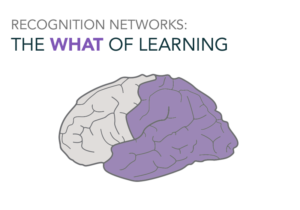The Learning Brain – Part One
Recently, I spoke at a wonderful Saturday-morning-gathering of parents and educators. I spoke on the Learning Brain Networks. In this three-part blog post series, I share with you, my blog readers, my notes for that presentation.
A 31-year-old man, asked me once, “How can I make my wife happy?” I responded glibly, “You don’t. You just love her.” I’ve been thinking about that exchange.
And wondering… Is there a difference between making someone happy and loving someone? You might be familiar with Gary Chapman’s book, the Five Languages of Love. Gary differentiates how someone receives love and how someone conveys love. By using the metaphor of language, he points out that we all speak a different love language. As an educator, I see the parallel of Gary Smalley’s Love Languages and learning differences. I have found empirical explanations for what you as parents and teachers also know intuitively about teaching children. And that is: Everyone learns differently! We can prove this with research findings. Let’s talk about the Learning Brain’s Networks.
One of the most wonderful benefits of living in 2017…
is that if we wanted to study your brain, we don’t have to kill you and perform an autopsy. Thanks to neuro imaging – CAT scans, PET scans, fMRI’s- we can study the brain while you are alive and observe you while you use your brain to perform higher order thinking tasks. This technological development helps us be more purposeful in our teaching approach. We can be better teachers and learners because we have more information about how the brain learns. We can learn how to use our brain, just the way we learn how to use our iPhone.
The Learning Brain Networks – Part One: Recognition Networks
My husband likes to watch the Rangers game on his computer and on the radio. Often, he will hear the strike-out before he sees it or he will hear the homerun before he sees it. Not all the input is arriving at the same time. Unlike seeing a time delay while watching the Rangers’ on the radio and on the computer, our brain processes sensory input in parallel and simultaneously.
Your sight is processing input simultaneously and in parallel with your hearing.
This parallel and simultaneous processing applies to all your senses, which explains how your interpretation of what you are hearing and seeing will be influenced by what you smell. The part of your brain that makes interprets sensory input is called your recognition networks and is located in the back half of the brain. To get a general idea of the location of your recognition networks, place the heel of your hands behind your ears and stretch out your fingers across your head.
Your recognition networks are highly specialized and efficient.
The brain has a specific area dedicated to processing one kind of sensory input.
There is a specific module dedicated to nuances of the sound coming from a stringed instrument. Another module is dedicated to processing lines diagonal, parallel, vertical, horizontal. These modules develop in response to our interaction with the environment. If you have never experienced something then you don’t have a module to process that information. For instance, if you grew up without hearing then at age 10 you were fitted with a cochlear implant, you will not have the module or networks in place to interpret and make meaning of this new auditory input.
Two people can witness the same event and interpret its meaning in a slightly different way because of the pattern of sensory processing is unique to them.
There are many things we might share, like language, same group of friends, maybe even the same church youth camp experience. All these commonalities will create a framework we use to shape our understanding and make meaning of life. However, there will always be individual differences attributed to unique life experiences and unique processing patterns in our brain. Two children could be in the same classroom with the same teacher but one is seated close to the door and the other close to the window. One of them could have just come back from a hunting trip with their dad and the other may have just come back from a funeral for their grandfather. These differences influence their learning experience.
Quick Re-cap
• The only way into our brains is through our senses.
• All the input is processed in parallel and simultaneously.
• All our senses influence each other in the task of recognizing and making meaning of the input.
• Our brain has specific regions to process specific type of sensory input.
As learners and teachers, how can we use this information about the Learning Brain Networks?
- Deliver instruction using as many senses as possible. For example: video with captions. Listening to a book and following along using a printed copy. Allow the learner to move around.
- Connect new information to previous information. Use real life illustrations or demonstrations.
- Make time for conversation.
- Include doodling or sketching while note-taking.

